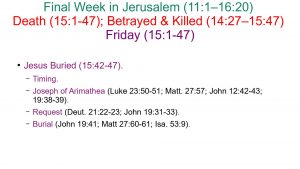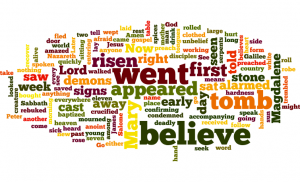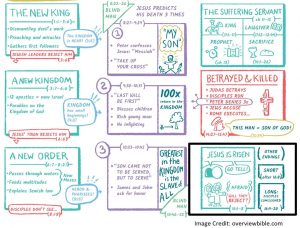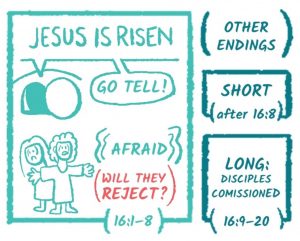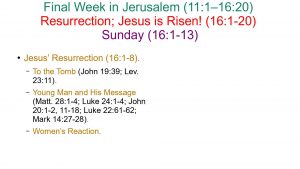Jesus’ Final Week in Jerusalem
Mark 11:1–16:20
Teaching (11:1–13:37)
King (11:1-11)
Sunday: Triumphal Entry (11:1-11).
Lawgiver (11:12–12:44)
Monday (11:12-19).
Tuesday (11:20–14:2).
Prophet (13:1-37)
Trial (14:1-72)
Sacrifice (14:1-26)
Wednesday (14:3-11).
Thursday (14:12-72)
Betrayed and Killed (14:27–15:47)
Death (15:1-47)
Friday (15:1-47).
Before Pilate (15:1-15).
Jesus Mocked (15:16-20).
Jesus Crucified (15:21-41).
Timing.
Joseph of Arimathea.
Request.
Burial.
Here it says that Joseph bought (really says that he had already bought) a piece of fine linen to wrap His body in—far better than that faded purple robe the guards placed on Him.
After Joseph had Him taken down, he wrapped Him in it, and buried Him in a stone tomb.
John records some interesting details about this tomb, that “in the place where He was crucified there was a garden, and in the garden a new tomb in which no one had yet been lain” (John 19:41).
So it was nearby, which is why the Church that sits atop the traditional location of the crucifixion is called the Church of the Holy Sepulchre, because Jesus was buried near where He was crucified.
This was Joseph’s own tomb (Matt. 27:60), but the custom at this time was that as soon as the body decayed enough, what remained would be placed into an ossuary—a small box.
This would have made the tomb available for Joseph later on anyway—if, of course, Jesus had stayed dead.
After all, this was a fulfillment of prophecy, that “they made His grave with the wicked—but with the rich at His death” (Isa. 53:9) – recall Joseph was a rich man.
And two of the women who witnessed His death stayed to witness His burial so they might be able to find His body to anoint it with spices after the Sabbath was done—Mary Magdalene and Mary the mother of Joses.
Matthew records that they were “sitting opposite the tomb” (Matt 27:61), faithful to the end.
But, as you and I both know, this was not the end—only the beginning!
Resurrection (16:1-20)
Jesus is Risen!
Jesus’ Resurrection (16:1-8).
To the Tomb.
Here we see these three women again (Mary Magdalene, Mary the mother of James and Joses, and Salome), women who witnessed the crucifixion, two of whom saw where Jesus was buried, and are now wanting to honor Him by anointing His body.
Nicodemus had the chance to anoint the body some when He was first buried (John 19:39), but the women wanted to come to complete the job.
They were hindered by time on Friday after His death, and to keep with the Law, they were unable to do so on the Sabbath.
 The Sabbath had ended on Saturday at sundown, but darkness prevented them from taking care of it that night.
The Sabbath had ended on Saturday at sundown, but darkness prevented them from taking care of it that night.So they chose the absolute earliest moment they could, at sunrise Sunday morning.
Evidently it was dark when they left, and the sun had just risen when they arrived in the garden near where Jesus was buried.
The burial rituals, with the linens and oils and spices, helped to preserve the body somewhat from the rapid decomposition that might occur in the heat of the day.
But there was a problem—they didn’t quite think ahead on how they were going to roll the very large stone away.
 Perhaps they didn’t know about the soldiers that Pilate had assigned to watch the tomb? Perhaps they had hoped they would find a helpful stranger along the way?
Perhaps they didn’t know about the soldiers that Pilate had assigned to watch the tomb? Perhaps they had hoped they would find a helpful stranger along the way?It was the in the middle of the Feast of Unleavened Bread and the Feast of the Firstfruits was that day, the day after the Sabbath (Sunday) after Passover (Lev. 23:11). Finding a helpful stranger might not have been so far-fetched, even at daybreak.
It was difficult to see so early in the day, but as they approached they finally noticed that they didn’t have to worry about that heavy stone after all!
The Young Man and His Message.
The sequence of events that occur here based on the various accounts appear, at first glance, to be difficult to reconcile, but it isn’t really (Matt. 28:1-4; Luke 24:1-4).
 Matthew says there was an angel, Mark says a young man wearing a long white robe, Luke says two men in shining garments, and John doesn’t say anything about it.
Matthew says there was an angel, Mark says a young man wearing a long white robe, Luke says two men in shining garments, and John doesn’t say anything about it.That’s easy to reconcile: there were two angels present, only one did the talking, and both were in the appearance of men.
Matthew says the angel was came down from heaven and was sitting on the stone, Mark says the young man was in the tomb sitting on the right, while Luke states that the two men were standing by them.
Again, easy to reconcile: One angel was sitting on the stone when the guards became as dead men, and when the women arrived, they both were sitting in the tomb to the right, then stood up to speak with them.
The women have the perfectly understandable reaction of being alarmed at the sight of these angels before them.
One of these angels speaks up, assuring them not to be alarmed and that they have the right tomb by stating who used to be here.
No doubt one thought going through their minds was, “Did we get the right tomb? What happened to Jesus?”
In fact, that’s exactly what Mary Magdalene thought, apparently not quite believing this angel, wondering what happened to the body (John 20:1-2, 11-18). This is evidenced later in the women’s reaction in Mark 16:8.
The angel tells them to go tell the disciples that He was going to see them in Galilee.
The angel here specifically singles out Peter for them to tell.
Recall the last time Peter had seen Jesus, right when they locked eyes after he denied Him, and he went out and wept bitterly (Luke 22:61-62).
What a comfort it would be to this sad disciple to see that Jesus hadn’t abandoned him even after his denials.
He’s going to go meet with them in Galilee as He said He would after He predicted they would all stumble and scatter after His death (14:27-28).
